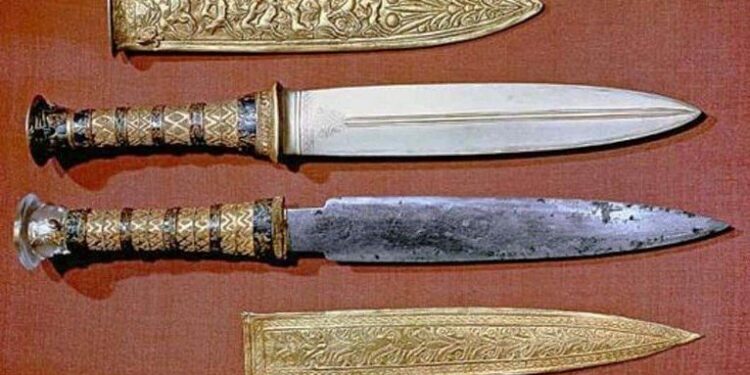The legend of King Tutankhamen’s space blade — an iron weapon made from meteorite rock and entombed with the ancient Egyptian monarch – may already be familiar to you.
A recent investigation has unearthed much more information about this most fascinating and mysterious of artifacts.
The type of meteorite most likely forged the dagger from and the procedure used to manufacture it was disclosed by a rigorous chemical investigation, including high-resolution photography and X-rays.

The discovery of a Widmanstätten pattern on the dagger indicates the long nickel-iron crystals found in octahedrite iron meteorites, the most common type of iron meteorite, are perhaps the most noteworthy.
“We did on-site non-contact, non-destructive two-dimensional chemical analysis for the dagger to understand the construction and provenance,” planetary scientist Tomoko Arai of Japan’s Chiba Institute of Technology told Gizmodo.
“We detected a cross-hatched texture on both sides [of the dagger], which we believe is Widmanstätten structure, indicative of an octahedrite iron meteorite.” That was our awe-inspiring moment.”
A low-temperature forging technique was most likely utilized to mold the weapon to keep the pattern. According to the researchers, the dagger was generated at temperatures below 950 degrees Celsius (1,742 degrees Fahrenheit the way would have faded.
Black marks support the artifact’s genesis story on the blade and inside a crack on the blade’s surface. The heating of troilite, an iron sulfide mineral in iron meteorites, is most likely to blame for these sulfur-rich locations.
The decorative stones were most likely fixed using lime plaster, which was not a general procedure in Egypt until considerably later in history, according to the chemical composition of the hilt. That suggests the dagger came from somewhere else.
The Amarna Letters, a collection of ancient Egyptian diplomatic correspondence dating from around 1360-1332 BCE and describe an iron knife sent to one of Tutankhamen’s ancestors as a present, may provide some hints to the experts.
“[The] gold hilt points at [the dagger’s] foreign provenance, presumably from Mitanni, Anatolia,” the researchers write in their article, “as evidenced by one of the Amarna letters claiming that an iron dagger with gold hilt was gifted from the ruler of Mitanni to Amenhotep III, Tutankhamen’s grandfather.”
This theory that the dagger came from somewhere other than Egypt has been proposed previously, but now we have further evidence. Further research should determine whether or not this is a family heirloom that has been passed down through the years.
The artifacts likely made iron artifacts from meteorite fragments that fell from space before the Iron Age and associated technologies. It would not have been an easy task, and it would almost certainly have involved a lot of trial and error.
Tsutomu Saito, a professor of cultural characteristics science at Japan’s National Museum of Japanese History, was not involved in the current study but has previously worked on iron forging research dating back before the Iron Age.






















